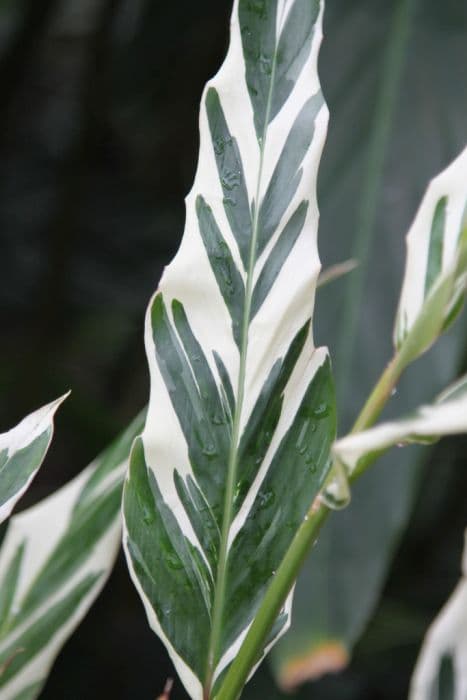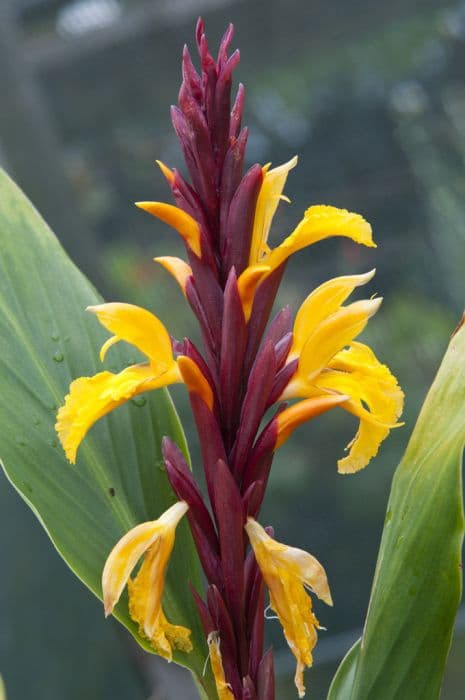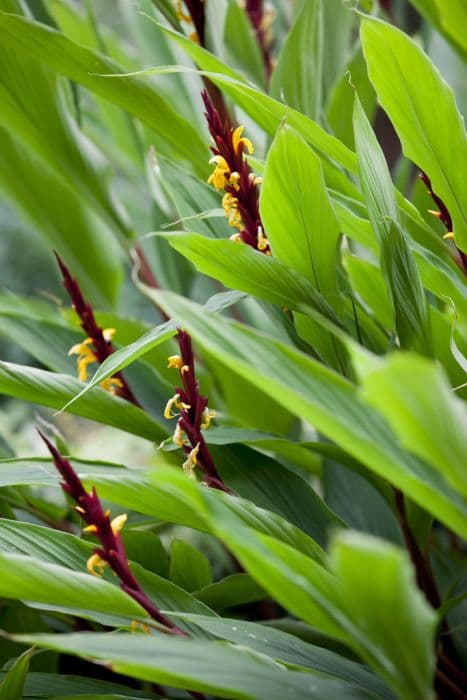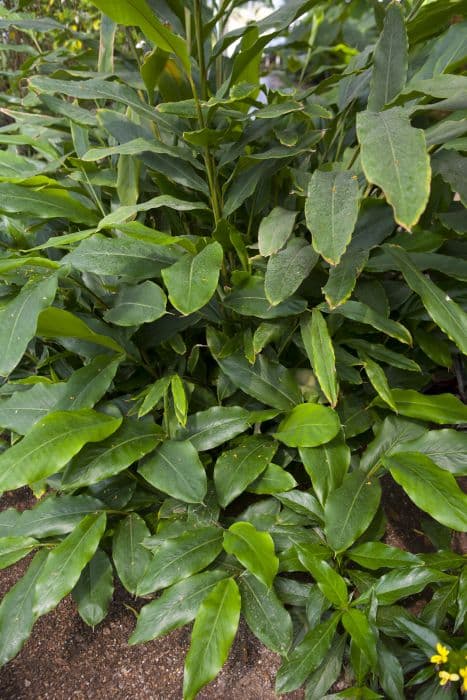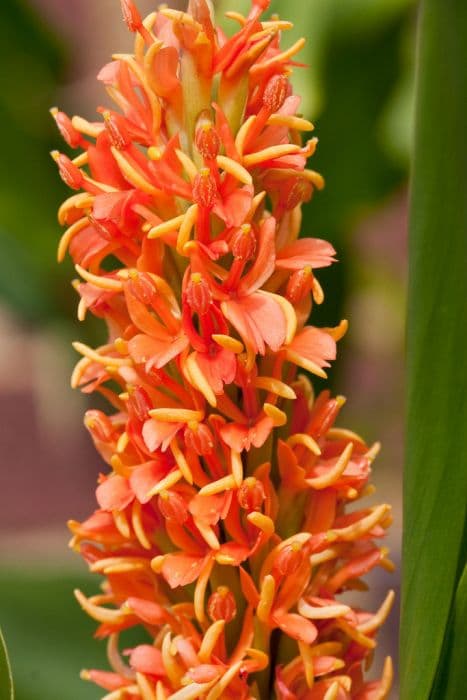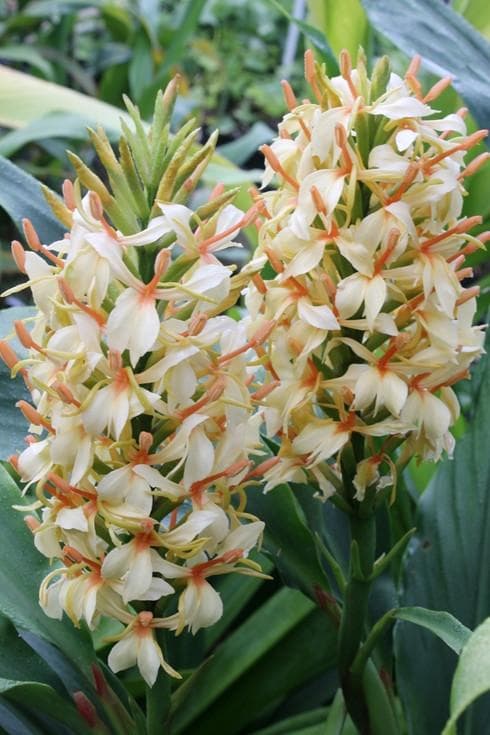Hardy Ginger Lily Roscoea × beesiana 'Monique'

ABOUT
Roscoea × beesiana 'Monique' is a perennial plant known for its striking appearance. It features large, orchid-like flowers that bloom in an eye-catching shade of purple. These flowers are characterized by a distinctive, hooded upper petal and a three-lobed lower lip, providing them with an elaborate and ornamental look that attracts attention in the garden. The lush, green leaves are lance-shaped, contributing to the plant's overall lush appearance. The foliage forms a clump from which the beautiful flowers emerge, creating a contrast that enhances the visual appeal of the blossoms. Each flower is borne on a sturdy, upright stem, which arises from the base of the plant, adding a vertical element to the foliage. Overall, Roscoea × beesiana 'Monique' showcases a rich palette of colors and a classic but exotic form, making it a stunning addition to any plant collection or garden setting without discussing its specific dimensions.
About this plant
 Names
NamesSynonyms
Monique Roscoea, Monique Hardy Ginger Lily.
Common names
Roscoea × beesiana 'Monique'.
 Toxicity
ToxicityTo humans
Roscoea × beesiana 'Monique', commonly referred to as hybrid Roscoea or ginger family member, does not have a well-documented profile regarding its toxicity to humans. There is limited available information suggesting the ingestion or handling of this plant causes harm to humans. However, as with any plant, individuals may have varying sensitivities, and it is always advisable to exercise caution and avoid ingesting plants that are not known to be safe for consumption.
To pets
Information regarding the toxicity of hybrid Roscoea to pets such as dogs and cats is not widely documented. This plant, being a member of the ginger family, is not commonly listed as toxic to pets. However, it is recommended that pet owners prevent their animals from ingesting plants that are not confirmed to be safe. If a pet ingests an unknown plant and exhibits symptoms of distress such as vomiting, diarrhea, or abnormal behavior, it is important to consult a veterinarian.
 Characteristics
CharacteristicsLife cycle
Perennials
Foliage type
Deciduous
Color of leaves
Green
Flower color
Purple
Height
1-2 feet (0.3-0.6 meters)
Spread
0.5-1 foot (0.15-0.3 meters)
Plant type
Herb
Hardiness zones
6
Native area
China
Benefits
 General Benefits
General Benefits- Aesthetic Appeal: Adds visual interest to gardens with its vibrant flowers and lush green foliage.
- Pollinator Attraction: Attracts bees and other pollinators, which are essential for the health of the ecosystem.
- Low Maintenance: Typically requires minimal care once established, making it suitable for gardeners of all skill levels.
- Hardiness: Adaptable to a range of soil types and conditions, demonstrating good resilience to climate variations within its hardiness zones.
- Seasonal Interest: Provides a splash of color during its flowering season, often in the summer months, enlivening gardens when many other plants may not be in bloom.
 Medical Properties
Medical PropertiesThis plant is not used for medical purposes.
 Air-purifying Qualities
Air-purifying QualitiesThis plant is not specifically known for air purifying qualities.
 Other Uses
Other Uses- Roscoea × beesiana 'Monique', commonly known as hybrid ginger, can be used in floral arrangements due to its attractive flowers.
- The plant can serve as a natural pest deterrent in gardens because some pests are repelled by the scent of its leaves.
- Hybrid ginger may be planted as a companion plant to help highlight the colors of surrounding plants in a mixed border.
- The flowers of hybrid ginger can be used to produce natural dyes for fabrics and art projects.
- Pressed flower craft enthusiasts may use the plant's flowers for bookmarks, cards, or other artistic endeavours.
- Gardeners may use the plant as an educational tool to study pollination, as it attracts bees and other pollinators.
- The sturdy leaves of hybrid ginger can be used in crafting, such as creating molds or impressions in clay or plaster.
- Due to its exotic appearance, hybrid ginger can be incorporated into themed gardens, such as Asian-inspired landscapes.
- The plant can be used in sensory gardens, where its textured foliage and vibrant flowers can be appreciated up close.
- Photographers might find hybrid ginger an intriguing subject for practicing macro photography due to the intricate details of its flowers.
Interesting Facts
 Feng Shui
Feng ShuiThe Roscoea plant is not used in Feng Shui practice.
 Zodiac Sign Compitability
Zodiac Sign CompitabilityThe Roscoea plant is not used in astrology practice.
 Plant Symbolism
Plant Symbolism- Rarity: Roscoea × beesiana 'Monique', commonly known as Beesiana Roscoea, is a hybrid species and not as commonly found as some other ornamental plants. This rarity can symbolize uniqueness or valuable qualities that are not easily found.
- Exotic Appeal: With its origins in Asian countries and hybrid status, the Beesiana Roscoea has an exotic appeal that can symbolize fascination with the unfamiliar or the allure of the unknown.
- Adaptability: Beesiana Roscoea, like other members of the Roscoea genus, can adapt to a variety of conditions in cultivation, symbolizing flexibility and resilience.
- Beauty in Simplicity: Despite its exotic appearance, the Beesiana Roscoea maintains a simple elegance, which can symbolize the idea that beauty often lies in simplicity and understatement.
 Water
WaterFor the Roscoea 'Monique', it is crucial to maintain evenly moist soil, especially during the growing season. It should be watered thoroughly whenever the top inch of soil feels dry to the touch. Depending on the environmental conditions and size of the plant, this may translate to approximately once a week, although less frequent watering is needed during the dormant period in winter. Each watering session should provide enough water to saturate the root zone, which could be around 1 inch of water each time. Overwatering can be detrimental to the health of the plant, so ensure proper drainage is in place.
 Light
LightRoscoea 'Monique' prefers a site with partial shade, protected from the harsh afternoon sun. It thrives under dappled light conditions, such as those provided by trees or taller plants, which can mimic its natural woodland habitat. Position it in a garden spot that receives several hours of morning sunlight but is shaded from the more intense midday and afternoon sun for optimal growth.
 Temperature
TemperatureRoscoea 'Monique' can survive in a temperature range that fluctuates from a minimum of about 50 degrees Fahrenheit to a maximum of around 86 degrees Fahrenheit. The ideal temperature for this plant to thrive is within the range of 60 to 75 degrees Fahrenheit. Extreme temperature fluctuations should be avoided to keep the plant healthy and ensure it continues to grow well.
 Pruning
PruningRoscoea 'Monique' does not require significant pruning, but any spent flowers or damaged leaves can be removed to maintain plant health and appearance. This gentle pruning can be done as needed throughout the growing season. The best time for pruning is usually after the flowering period when you can deadhead the old flowers to possibly encourage a second bloom.
 Cleaning
CleaningAs needed
 Soil
SoilThe Roscoea, commonly known as Hardy Ginger, thrives in a rich, well-draining soil mix with plenty of organic matter. Aim for a soil pH around 6.5 to 7.0. A mix of loamy garden soil, well-rotted compost, and a small amount of sand or perlite for improved drainage makes an ideal soil composition for this plant.
 Repotting
RepottingHardy Gingers like Roscoea should be repotted every 2-3 years to ensure they have fresh soil and adequate room to grow. Repotting is best done in the spring before the new growth starts.
 Humidity & Misting
Humidity & MistingHardy Ginger plants prefer high humidity conditions to thrive, ideally around 60-70%. They benefit from a moist environment, but it's essential to ensure good air circulation to prevent fungal diseases.
 Suitable locations
Suitable locationsIndoor
Place Hardy Ginger in bright, indirect light and maintain high humidity.
Outdoor
Plant Hardy Ginger in partial shade, protect from strong winds.
Hardiness zone
6-9 USDA
 Life cycle
Life cycleRoscoea × beesiana 'Monique', commonly known as Monique Roscoea, begins its life cycle as a rhizome buried in the soil, which in spring develops into a shoot that emerges above ground. The plant grows leaves that unfurl and photosynthesize, leading to the development of stems and eventually producing striking orchid-like purple flowers during the summer. After pollination, which may occur through the activity of insects, the flowers form seed capsules containing seeds that ripen by late summer or early autumn. When the seeds disperse, they can germinate in the soil to produce new plants, continuing the cycle. In winter, the aerial parts of the plant die back, while the rhizome survives underground in a dormant state until the next growing season. This perennial cycle repeats every year, with the plant slowly increasing in size and the number of flowering shoots as the rhizome expands.
 Propogation
PropogationPropogation time
Spring-Early Summer
The most popular method of propagating Roscoea × beesiana 'Monique', commonly known as hybrid Roscoea, is through division. This is typically done in spring as new growth becomes apparent. The clump of the parent plant is carefully dug up, and a sharp knife is used to divide the rhizome into sections, ensuring that each section has at least one growth bud. The divisions are then planted immediately at the same depth they were previously growing, approximately 3 to 5 inches (8-13 centimeters) deep, in a mix of well-draining soil. It's important to water the new divisions gently to settle the soil around the rhizomes and eliminate any air pockets. This method is straightforward and helps to rejuvenate older clumps as well as increase your stock of the plants.
